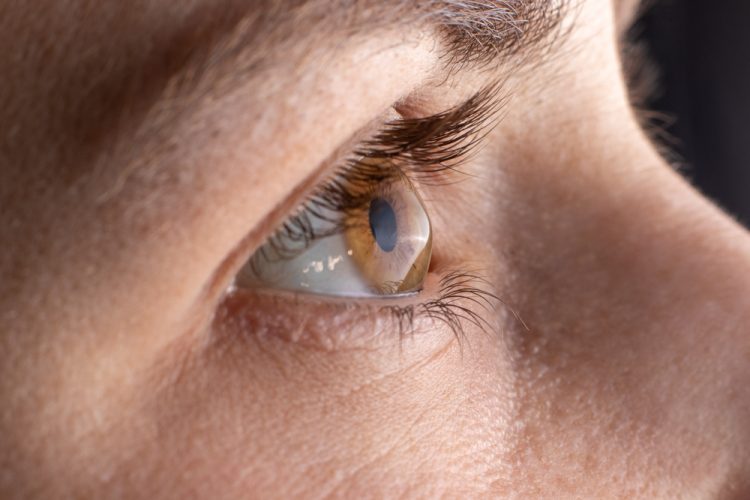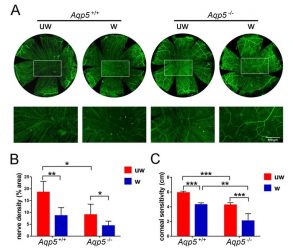Utilising aquaporins could be the key to repairing corneal defects
Posted: 1 October 2021 | Anna Begley (Drug Target Review) | No comments yet
New evidence suggests that aquaporin 5 (Aqp5) induction promotes corneal epithelial regeneration, which could lead to possible therapies.


A new study conducted at Qingdao University, China, provides exciting evidence supporting the involvement of aquaporins in corneal cell proliferation and nerve regeneration and suggests aquaporin 5 (AQP5) induction as a potential therapy to accelerate the resurfacing of corneal defects.


(A) Staining for β-tubulin III in Aqp5+/+ and Aqp5-/- mice before and 48 hours after central corneal scraping. Images of the entire cornea are shown in the top panels, and central cornea images are shown in the bottom panels. Scale bars: 400 μm (bottom panels). (B) Nerve densities of the entire cornea (a, top panels) are calculated on the basis of the areas staining positive for β-tubulin III using Image J software (n=6). (C) Histogram of corneal sensitivity in Aqp5+/+ and Aqp5-/- mice before and 48 hours after central corneal scraping (n=6). uw, unwound; w, wound. *P < 0.05; **P < 0.01; ***P < 0.001.
“As a member of aquaporin family, AQP5 is expressed in cornea, which is related to many eye diseases,” explained Peng Chen, lead investigator of the study, which was published in The American Journal Pathology. “If a corneal injury cannot heal in time, it may lead to pathogen invasion and result in corneal inflammation, turbidity, ulcer(ation) and even blindness. In previous studies, we found that AQP5 deficiency can cause corneal epithelial punctate defects.
“There is also increasing evidence that nerve growth factor (NGF) plays a key role in corneal wound healing. AQP5 deficiency can slow down the repair of corneal epithelial injury in mice, but its specific mechanism remained unclear. We hypothesised that AQP5 plays an important role in one or more stages of corneal epithelial regeneration and explored the specific mechanism of AQP5,” continued Chen.
The researchers generated an Aqp5 knockout (Aqp5-/-) mouse model and performed corneal wound healing on corneas from which epithelial cells had been scraped away. They used 75 male Aqp5+/+ mice and 189 male Aqp5-/- mice aged 10 to 12 weeks. Time to corneal epithelial and nerve regeneration was significantly delayed in the Aqp5-/- mice.
To determine the role of NGF in the repair of corneal epithelial injury, NGF was injected in the subconjunctival space after corneal epithelium was scraped off in Aqp5-/- mice. The epithelial and nerve regeneration rate were significantly promoted in Aqp5-/- mice with the treatment of NGF, which also improved the recovery of corneal nerve fibre density and sensitivity in Aqp5-/- mice, accompanied by recovered levels of phosphorylated Akt.
The investigators also administered an Akt inhibitor in addition to NGF in Aqp5-/- mice to determine the mechanism of NGF regulating the repair rate of corneal epithelial injury. However, the promotion of NGF induced corneal epithelial and nerve regeneration rate and Akt reactivation was reversed by the Akt inhibitor.
Learn how CRISPR-Cas9 can prevent Fuchs’ corneal dystrophy in mice – READ HERE
“It is exciting to find that Aqp5 deficiency can affect the nerve regeneration of mice by affecting the activation of NGF and Akt signalling pathways, which is not found in previous studies,” commented Chen. “These results need to be confirmed in a clinical setting, but they provide evidence for the involvement of aquaporins in cell proliferation and nerve regeneration and suggest AQP5 induction as a possible therapy to accelerate the resurfacing of corneal defects.”
Related topics
Drug Targets, In Vivo, Small molecule, Therapeutics
Related conditions
corneal disorder
Related organisations
Qingdao University
Related people
Peng Chen PhD



